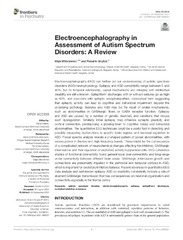Приказ основних података о документу
Electroencephalography in Assessment of Autism Spectrum Disorders: A Review
| dc.creator | Milovanovic, Maja | |
| dc.creator | Grujicic, Roberto | |
| dc.date.accessioned | 2021-10-26T06:50:57Z | |
| dc.date.available | 2021-10-26T06:50:57Z | |
| dc.date.issued | 2021 | |
| dc.identifier.issn | 1664-0640 | |
| dc.identifier.uri | http://rfasper.fasper.bg.ac.rs/handle/123456789/3662 | |
| dc.description.abstract | Electroencephalography (EEG) can further out our understanding of autistic spectrum disorders (ASD) neurophysiology. Epilepsy and ASD comorbidity range between 5 and 46%, but its temporal relationship, causal mechanisms and interplay with intellectual disability are still unknown. Epileptiform discharges with or without seizures go as high as 60%, and associate with epileptic encephalopathies, conceptual term suggesting that epileptic activity can lead to cognitive and behavioral impairment beyond the underlying pathology. Seizures and ASD may be the result of similar mechanisms, such as abnormalities in GABAergic fibers or GABA receptor function. Epilepsy and ASD are caused by a number of genetic disorders and variations that induce such dysregulation. Similarly, initial epilepsy may influence synaptic plasticity and cortical connection, predisposing a growing brain to cognitive delays and behavioral abnormalities. The quantitative EEG techniques could be a useful tool in detecting and possibly measuring dysfunctions in specific brain regions and neuronal regulation in ASD. Power spectra analysis reveals a U-shaped pattern of power abnormalities, with excess power in the low and high frequency bands. These might be the consequence of a complicated network of neurochemical changes affecting the inhibitory GABAergic interneurons and their regulation of excitatory activity in pyramidal cells. EEG coherence studies of functional connectivity found general local over-connectivity and long-range under-connectivity between different brain areas. GABAergic interneuron growth and connections are presumably impaired in the prefrontal and temporal cortices in ASD, which is important for excitatory/inhibitory balance. Recent advances in quantitative EEG data analysis and well-known epilepsy ASD co-morbidity consistently indicate a role of aberrant GABAergic transmission that has consequences on neuronal organization and connectivity especially in the frontal cortex. | |
| dc.publisher | Frontiers Media [Commercial Publisher] | |
| dc.rights | openAccess | |
| dc.rights.uri | https://creativecommons.org/licenses/by/4.0/ | |
| dc.source | Frontiers in Psychiatry | |
| dc.subject | autistic spectrum disorder | |
| dc.subject | electroencephalography | |
| dc.subject | epilepsye | |
| dc.subject | epileptiform discharges | |
| dc.subject | excitation/inhibition imbalance | |
| dc.title | Electroencephalography in Assessment of Autism Spectrum Disorders: A Review | |
| dc.type | article | en |
| dc.rights.license | BY | |
| dc.citation.rank | M21 | |
| dc.citation.spage | 686021 | |
| dc.citation.volume | 12 | |
| dc.identifier.doi | 10.3389/fpsyt.2021.686021 | |
| dc.identifier.fulltext | http://rfasper.fasper.bg.ac.rs/bitstream/id/3973/fpsyt-12-686021.pdf | |
| dc.identifier.scopus | 2-s2.0-85117083532 | |
| dc.identifier.wos | 000717238000001 | |
| dc.type.version | publishedVersion |


